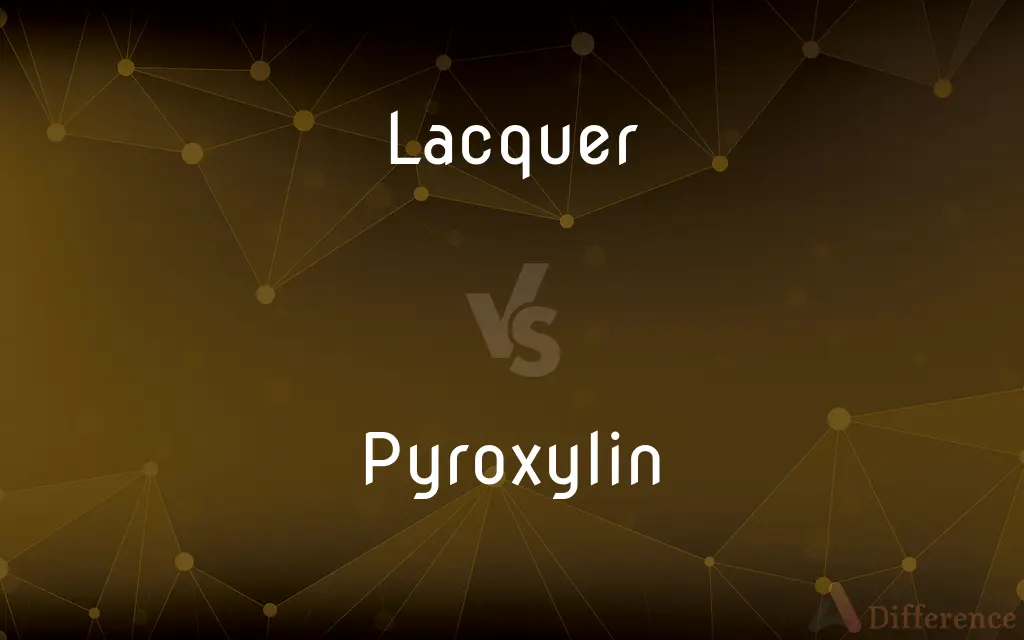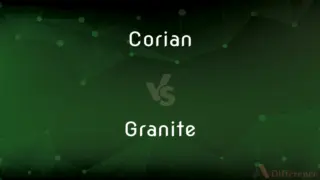Lacquer vs. Pyroxylin — What's the Difference?
Edited by Tayyaba Rehman — By Fiza Rafique — Updated on May 9, 2024
Lacquer is a protective finish derived from natural resins, providing a durable, glossy finish, while pyroxylin is a type of nitrocellulose used in making celluloid and photographic film, notable for its flammability.

Difference Between Lacquer and Pyroxylin
Table of Contents
ADVERTISEMENT
Key Differences
Lacquer is traditionally made from the sap of the lacquer tree, used primarily as a high-gloss varnish for wood and other materials. It is known for its ability to dry quickly to a hard and smooth surface, providing excellent protection and aesthetic appeal. On the other hand, pyroxylin is a chemical compound created by treating cellulose with nitric acid, resulting in a highly flammable product used in various industrial applications, including the production of plastics and films.
In terms of application, lacquer is commonly applied to furniture, musical instruments, and other wooden items to enhance their appearance and durability. It can be clear or pigmented and is appreciated for its repairability and resistance to moisture. Whereas pyroxylin, due to its properties, is utilized in the manufacture of celluloid, historically significant in the production of film stocks and early plastics, offering a different kind of utility focused on manufacturability and flexibility.
The environmental impact of these materials also differs. Lacquers, especially those based on synthetic resins, can release volatile organic compounds (VOCs) during application and drying, posing health and environmental risks. Conversely, pyroxylin, while less concerning in terms of VOC emissions, poses significant fire and safety hazards due to its high flammability, impacting its handling and storage requirements.
The development of lacquers has evolved to include water-based and low-VOC formulas, addressing environmental and health concerns associated with traditional lacquers. In contrast, pyroxylin has seen a decline in use with the advent of safer, more stable synthetic materials that replicate or surpass the properties of nitrocellulose-based products without the associated risks.
In the historical context, lacquer has been used for thousands of years, particularly in East Asian art and craftsmanship, symbolizing cultural heritage and artistic achievement. Pyroxylin played a crucial role in the development of the film industry and early plastics, marking significant technological advancements in the late 19th and early 20th centuries, though its use has diminished over time due to safety concerns and the rise of modern polymers.
ADVERTISEMENT
Comparison Chart
Base Material
Natural resins (often from the lacquer tree)
Nitrocellulose (cellulose treated with nitric acid)
Main Uses
Protective and decorative finishes for wood
Manufacture of celluloid and photographic films
Drying Time
Fast-drying to a hard, protective finish
N/A
Environmental Impact
Releases VOCs, newer versions are low-VOC
High flammability, lesser VOC concerns
Historical Significance
Used in East Asian art and craftsmanship for millennia
Crucial in early film and plastic industries
Compare with Definitions
Lacquer
In historical contexts, refers to a craftsmanship technique.
Traditional Japanese lacquerware requires skilled artisans.
Pyroxylin
Known for its flammable properties.
Care must be taken when handling pyroxylin due to its flammability.
Lacquer
Used to describe high-gloss paints.
The red lacquer paint gave the car a striking appearance.
Pyroxylin
A component in some early synthetic fibers.
Pyroxylin contributed to the development of synthetic textiles.
Lacquer
Can refer to a clear or colored wood finish.
The antique desk featured a dark brown lacquer that highlighted its age.
Pyroxylin
Integral to the creation of celluloid.
Celluloid, made from pyroxylin, was used for film before digital media.
Lacquer
A fast-drying protective coating.
He applied lacquer to the wooden table to prevent scratches.
Pyroxylin
A form of nitrocellulose used in plastics and films.
Pyroxylin was essential in the manufacturing of early plastics.
Lacquer
A varnish made from resin, providing a glossy finish to wood.
The cabinet was coated with several layers of lacquer for a polished look.
Pyroxylin
Used historically in photographic films.
Pyroxylin-based films were a staple in early photography.
Lacquer
The term lacquer is used for a number of hard and potentially shiny finishes applied to materials such as wood or metal. These fall into a number of very different groups.
Pyroxylin
See nitrocellulose.
Lacquer
Any of various clear or colored synthetic coatings made by dissolving nitrocellulose or other cellulose derivatives together with plasticizers and pigments in a mixture of volatile solvents and used to impart a high gloss to surfaces.
Pyroxylin
(organic compound) A highly inflammable form of nitrocellulose; used in the manufacture of collodion and lacquers.
Lacquer
A glossy, resinous material, such as the processed sap of the lacquer tree, used as a surface coating.
Pyroxylin
Highly flammable nitrocellulose used in making collodion and plastics and lacquers
Lacquer
A finish that is baked onto the inside of food and beverage cans.
Lacquer
To coat with lacquer.
Lacquer
To give a sleek, glossy finish to.
Lacquer
A glossy, resinous material used as a surface coating; either a natural exudation of certain trees, or a solution of nitrocellulose in alcohol, etc.
Lacquer
A similar finish, baked onto the inside of cans.
Lacquer
To apply a lacquer to something or to give something a smooth, glossy finish.
Lacquer
A varnish, consisting of a solution of shellac in alcohol, often colored with gamboge, saffron, or the like; - used for varnishing metals, papier-maché, and wood. The name is also given to varnishes made of other ingredients, esp. the tough, solid varnish of the Japanese, with which ornamental objects are made.
Lacquer
To cover with lacquer.
Lacquer
A black resinous substance obtained from certain trees and used as a natural varnish
Lacquer
A hard glossy coating
Lacquer
Coat with lacquer;
A lacquered box from China
Common Curiosities
What is lacquer typically made from?
Lacquer is typically made from the sap of the lacquer tree or synthetic polymers.
How does lacquer affect the environment?
Traditional lacquer can release harmful VOCs, though newer formulas are designed to be more environmentally friendly.
What are the benefits of using lacquer on musical instruments?
Lacquer enhances the instrument's durability and aesthetic appeal while protecting it from environmental factors.
What are the primary uses of pyroxylin?
Pyroxylin is primarily used in the manufacture of celluloid and photographic films.
Why has the use of pyroxylin declined?
Due to its flammability and the development of safer alternatives, pyroxylin's use has significantly declined.
What replaced pyroxylin in photographic films?
Safer and more stable synthetic polymers have replaced pyroxylin in photographic films.
What safety concerns are associated with pyroxylin?
Pyroxylin is highly flammable, posing significant safety risks during handling and storage.
How does lacquer enhance the appearance of wood?
Lacquer provides a glossy, protective finish that enhances the wood's natural beauty and grain.
Are there any non-wood applications for lacquer?
Yes, lacquer can also be applied to metal and other materials for protective and decorative purposes.
How does pyroxylin's flammability impact its industrial use?
Its high flammability limits its use, requiring strict safety measures in industrial environments.
What historical significance does pyroxylin hold?
Pyroxylin was crucial in the early development of the film and plastic industries.
How can one safely handle pyroxylin in industrial settings?
Proper ventilation, fire safety measures, and handling protocols are essential when working with pyroxylin.
Can pyroxylin still be found in modern products?
Pyroxylin has largely been replaced by safer, more stable materials in most applications.
What types of lacquer are available today?
Today's lacquers include water-based, solvent-based, and low-VOC varieties to meet diverse needs and regulations.
How long has lacquer been used in craftsmanship?
Lacquer has been used for thousands of years, especially in East Asian cultures.
Share Your Discovery

Previous Comparison
Duty vs. Function
Next Comparison
Corian vs. GraniteAuthor Spotlight
Written by
Fiza RafiqueFiza Rafique is a skilled content writer at AskDifference.com, where she meticulously refines and enhances written pieces. Drawing from her vast editorial expertise, Fiza ensures clarity, accuracy, and precision in every article. Passionate about language, she continually seeks to elevate the quality of content for readers worldwide.
Edited by
Tayyaba RehmanTayyaba Rehman is a distinguished writer, currently serving as a primary contributor to askdifference.com. As a researcher in semantics and etymology, Tayyaba's passion for the complexity of languages and their distinctions has found a perfect home on the platform. Tayyaba delves into the intricacies of language, distinguishing between commonly confused words and phrases, thereby providing clarity for readers worldwide.
















































